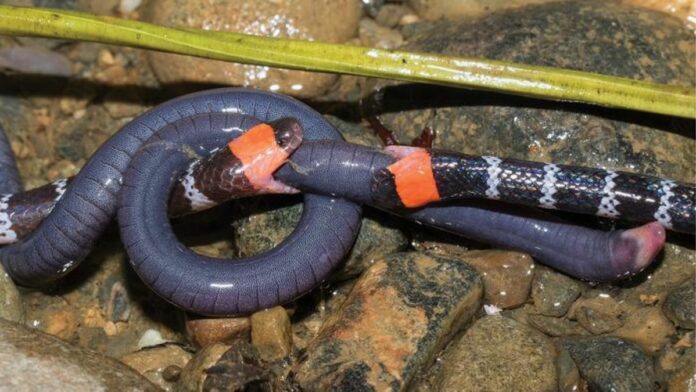Two red-tailed coral snakes have been spotted fighting over food for the first time ever.
The two extremely venomous snakes have been photographed feasting on the same caecilian. This is the first-ever documented case of kleptoparasitism, or food theft, in the Elapidae snake family.
The documentation has been published in a new study in the international peer-reviewed open access journal of the Austrian Herpetological Society, Herpetozoa. Footage of the serpents appear to show the two snakes in a tug of war, with their jaws tightly gripped around the prey.
The fight between the two snakes took place in the rainforest of Valle del Cauca in western Colombia. During the observation, the study reports that one snake bit the other. It is thought, however, that this was accidental. The battle continued for 17 minutes before one coral snake lost and released the prey to the other. The winning snake then slithered away with its meal.
Henrik Bringsøe and Niels Poul Dreyer
Food theft has been documented in animal species before. However, the observation among snakes in their natural environment is extremely rare. It is more common with serpents in captive environments, the study reports.
“Snakes in captivity do that often when only one prey is offered in a terrarium with two or more snakes. But it is rather surprising that it has not been observed more frequently in the wild,” lead author of the study Henrik Bringsøe said in a statement.
Food theft in the wild are underreported because of the “elusive nature” of these snakes. Observing them in the wild, let alone seeing this type of behaviour, is tricky.
The red-tailed coral snake is an elapid, which is one of the deadliest snake families in the world. There are 400 diverse species in this family including mambas, cobras, kraits, taipans, tiger snakes, death adders, sea snakes and coral snakes. The red-tailed coral snake is native to Central America and northern Southern America.
The study sheds new insight into the snake species and how it interacts with its prey.
“It is well-known that [these snakes] eat caecilians, but this is the first observation of kleptoparasitism in elapid snakes in the wild,” the authors wrote in the study.
“It is considered likely that they rely on chemoreception when detecting caecilians, notably in this case as two coral snakes detected the same prey item. In general, kleptoparasitism may occur more frequently amongst snakes than indicated by the very few published cases considering that numerous cases from captivity are known.”
Do you have a tip on a science story that Newsweek should be covering? Do you have a question about snakes? Let us know via [email protected].
Uncommon Knowledge
Newsweek is committed to challenging conventional wisdom and finding connections in the search for common ground.
Newsweek is committed to challenging conventional wisdom and finding connections in the search for common ground.


